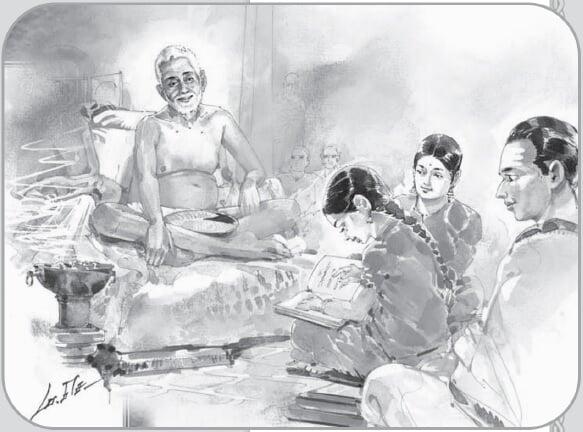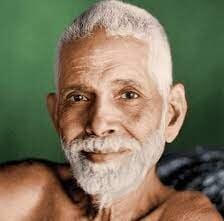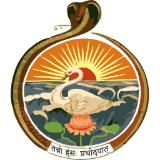Swami Vivekananda exhorted, ‘The abstract Advaita must become living—poetic—in everyday life; out of hopelessly intricate mythology must come concrete moral forms; and out of bewildering Yogi-ism must come the most scientific and practical psychology—and all this must be put in a form so that a child may grasp it.’
Deriving inspiration from Swamiji’s words, Swami Vimurtananda, had taken efforts to weave the eternal values into wonderful stories so that anyone would be able to imbibe them and enrich their personal and social lives.
The valuable teachings of Sri Ramakrishna, Holy Mother Sri Sarada Devi, and Swami Vivekananda which are most relevant to the modern age are embodied in these short stories endowed with literary grace, cultural enrichment and spiritual wisdom, inspiring our hearts and instructing our minds.

Whoever closes the eyes and meditate, do they really capture the divine within them? But whenever little Lalita and Indira closed their eyes, their minds constantly hover around the holy feet of the great saint Ramana Maharishi.
The little girl Lalita was naughty and smart while her younger sister Indira was quiet and composed. They both were daughters of the renowned poet and college professor Gurram Venkata Subbaramaiah hailing from Andhra Pradesh.
At the earliest opportunity, Subbaramaiah would rush to Tiruvannamalai and attain pearly wisdom by submerging himself in saint Ramana’s presence.
In the year 1937, he visited Ramana Ashram with his elder daughter Lalita. The meditation hall in the Ashram was a paradise on earth for Ramana’s devotees. It played host to all kinds of seekers—those who sought inner peace, those who sought the truth and those who sought the Self. As all these seekers gathered around, Ramana sat amidst them as the light of the divine congregation.
Lalita, being naughty and hyperactive, couldn’t sit for long at one place. She wandered here and there in search of someone to play with. Beautiful peacocks roamed about but she could not chase them. Monkeys jumped from tree to tree but she was too scared to go near them. Squirrels played in harmony but sprinted away when she came to them. The dogs tried to follow her, but she was repulsed by their rashes and phlegm.
Everyone in the hall was seated upright with eyes closed, chanting and trying to meditate under the guidance of the Maharishi. There was no one to play with Lalita. When she looked around, only the ‘grandpa swami’ seated in the centre seemed to be free. ‘He is the only one fit for me,’ thought Lalita.
She went and stood beside the revered Maharishi. Was she there to serve him? Not at all! She was there to merely play her pranks. She would shake his fan and make a noise. She would flip his books and make them fall. Some of the devotees would give her an admonishing look.
But nothing could restrain her. She considered the ashram as her own home and the divine Maharishi as her playmate. It was only when her mischief disturbed the devotees the Maharishi reprimanded her. ‘Hey, what are youdoing, my child?’ he would ask appearing to be slightly angry.
Lalita would immediately pout her mouth, shake her head and innocently reply, ‘I didn’t do anything Swami. I am just standing here.’ Indeed! It was fascinating to see the little one deny her mischievous play.
The Maharishi himself would laugh aloud at the innocent pranks of this little girl. ‘Look, this small girl is up to non-stop mischief. But when asked to explain, she innocently pleads ignorance by saying “I didn’t do anything”. As a child, she is able to speak like this. But as elders, we are not able to understand it,’ remarked the Maharishi. Thus he explained the essence of the Gita through the mischievous ways of an innocent child.
In the third week of May in the year 1941, Subbaramaiah was once again at the Ashram. This time along with the 9-year-old Lalita, he also brought his younger daughter, the 5-year-old Indira. Dressed in silk clothes, both the girls played around like chirpy birds and were the cynosure of all eyes.
Most importantly, Ramana Maharishi became extremely fond of Indira. If he asked her to sing, she happily sang. If he asked her to dance, she readily obeyed.
But what had happened to Lalita? She had become very shy and conscious of herself. Was it the age? Has ‘Dehatma Buddhi’ – body consciousness sprouted in her? Was that why she felt uncomfortable in front of the Maharishi?
Once Indira had finished singing, Ramana asked Lalita to sing. She hesitated. But the Maharishi would not leave her.
‘What is this, Lalita? I never asked anything from anyone. But here I am, requesting you to sing, and you are not willing to do so. Look at your little sister Indira. Why can’t you sing like her?’ asked the Maharishi.
It was only after much persuasion that Lalita began to sing. Later both the girls danced together and entertained all the devotees. Maharishi’s court
was vibrant and colourful. By making these young girls dance, did Maharishi try to soothe the environment and thereby lighten the hearts of those with a higher quest of ‘Who am I?’.
It was the dawn of another day at the Ashram. Subbaramaiah sat before the Maharishi and read a Telugu book named Upadesa Saaram. On the front page of this book was written four Sanskrit words–‘Naaham Deham–Koham–Soham’ (I am not the body–Who am I?–I am He).
On seeing these words, the young Indira tried to read them aloud by spelling out the letters of every word.
The Maharishi looked at Indira with deep love, emotion and grace. He could sense a spring of spiritual knowledge blossoming within her.
‘Indira, my dear, you read out those words beautifully. You don’t have to read the rest of the passage. The words that you now chanted form the essence of all spiritual knowledge. Just continue chanting these words like a sacred mantra. In it you will find all wisdom,’ he remarked.
Immediately, Indira started humming to herself the sacred chant taught by her beloved grandpa Swami.
Once she became confident, she turned the words into a tune and started singing it aloud in different ragas. Whenever he chanced to look at Indira, Maharishi would ask, ‘Now chant that mantra. Let me see.’ She would immediately do so like an obedient disciple.
Was the Maharishi focusing on her pronunciation? Or was he preparing her for a higher plane in life?
This sacred chant was first given by Ramana to one of his principal disciples, the revered scholar, Kaavya Kanda Ganapathi. This pranayama mantra was meant for spiritual seekers who had scaled great heights. It was not something which could be mastered by ordinary souls.
Firstly, the seeker should breathe in with the chant Koham–(Who am I?) a contemplative question of dilemma, on deep inhalation (Pooraka).
Next he should learn to hold the breath and chant Soham (I am He) – as an answer to all queries, on retention of breath (Kumbhaka).
Lastly, he should breathe out the chant NaahamDeham (I am not this body) as an experience, on exhalation (Rechaka). This is termed as Jnana Pranayama (the breathing of Knowledge).
‘Ah! What a wonderful mantra,’ thought Subbaramaiah as he reflected on the true meaning of this sacred chant. But there was one unanswered question which continued to bother him.
‘There are so many of us, spiritual seekers knowledgeable and experienced, waiting for the revered Maharishi to shower his spiritual grace on us. But why is he stuffing such a high concept into a little girl like Indira? What will she understand?’ he wondered.
One day, Subbaramaiah was in deep meditation. Indira was hungry. But she sat quietly in a corner without disturbing her father.
The great Maharishi who was aware of everything, be it hunger for food or longing for God, noticed the little child in the corner. He looked at her father and said, ‘The child is hungry. Without taking care of her what is the big need for meditation?’ Subbaramaiah opened his eyes and immediately took care of his daughter’s needs.
On yet another day, the Maharishi was playfully talking to both the girls. He then looked at Lalita’s hands and asked, ‘Dear, whose hand is this?’
‘It is my hand,’ Lalita replied. ‘No, my child,’ remarked the saint.
He then asked, ‘Whose eye is this?’
‘It is my eye,’ she answered. ‘No, it’s not,’ the Maharishi once again remarked.
In this way he asked about different parts of her body and every time Lalita’s answer was the same. At the end, the Maharishi replied, ‘My child, nothing is yours. Your body belongs to God and God alone.’ Lalita blinked her eyes.

On the other hand, Indira who was listening to this entire conversation was enamoured by Maharishi’s words and thought, ‘Is that so? Is this body not mine?’ She thus absorbed every word that the great saint uttered.
The holidays came to an end. The two girls came to bid goodbye to the Maharishi.
It was early in the morning, the time for the revered saint to go up the great Arunachala Mountain. Lalita stood before him looking around aimlessly in all directions. But the little Indira looked as if she was deeply craving for something.
The saint looked deeply at Indira and said, ‘Alright. Now you go to your place and I go to mine.’ He then started to climb up the sacred Arunachala Mountain.
Indira’s heart was heavy with sadness. Will not the revered Maharishi turn back and look at her? ‘Grandpa Swami, when will I get to see you next?’ she wondered. But there was one great consolation. She now had the three mantras that Maharishi had taught her. ‘If I chant them, I am sure wherever I am, grandpa Swami will take care of me,’ she told herself with firm conviction.
On reaching their hometown, the girls wrote separate letters to their father who was still at the Ashram. The letters were placed before the revered Maharishi.
Indira’s letter read as follows: ‘Father, please tell the revered Swami that I am constantly thinking of him. I am also regularly chanting his mantras.’
On hearing this, the Maharishi keenly looked at the letter. What did that divine look mean? That he would not be seeing Indira again? Or that she had truly excelled in spiritual life and was soon going to get her purpose of life fulfilled?
Days went by at a fast pace turning months into years.
It was the year 1943. It was two years since Indira last visited the Ashram. She had grown into a wonderful girl, both internally and externally.
But one day, she was suddenly infected with an extreme case of small pox. In two weeks she lost all vigour and vitality and was completely bedridden. She could not eat or sleep.
Although she endured great suffering and bodily pain, she continued to chant the divine given by Maharishi. As soon as she started chanting, her face would lit up with a glow. Though her breathing became irregular, her chanting continued with a rhythmic flow. She was placed in front of the divine image of Ramana Maharishi with devotees all around praying for her good health and recovery.mantras given by Maharishi. As soon as she started chanting, her face would lit up with a glow. Though her breathing became irregular, her chanting continued with a rhythmic flow. She was placed in front of the divine image of Ramana Maharishi with devotees all around praying for her good health and recovery.given by Maharishi. As soon as she started chanting, her face would lit up with a glow. Though her breathing became irregular, her chanting continued with a rhythmic flow. She was placed in front of the divine image of Ramana Maharishi with devotees all around praying for her good health and recovery.
Subbaramaiah, who was a literary scholar, could feel that his daughter was in the process of creating an epic tale of tragedy. It was only now that he realized that the Maharishi had foreseen Indira’s destiny and had hence taught her the spiritual to guide her in her journey beyond this material world. With this realization, his respect and devotion for the great saint grew by leaps and bounds.mantras to guide her in her journey beyond this material world. With this realization, his respect and devotion for the great saint grew by leaps and bounds.to guide her in her journey beyond this material world. With this realization, his respect and devotion for the great saint grew by leaps and bounds.
Although the remaining days were miserable for those around her, Indira was filled with inner peace and tranquillity.
That tragic day came at last. It was on the 13th of April, the sacred day of Sri Ramanavami, Indira, with devotees standing around her, chanted the three mantras in one breath and then breathed her last.
Those who were there could offer no condolences. Everyone believed that Indira had cast away her mortal body and had truly become one with the Creator.
‘What most people cannot achieve even after several years of spiritual practice, this little girl has achieved within a short period due to the divine grace of her revered guru,’ felt all the devotees.
On the place where Indira’s body was buried, Subbaramaiah raised a tombstone on which were engraved the words: ‘Naaham Deham–Koham–Soham’.
That tombstone and those divine words continue to guide the devotees even to this day.
Swami Vimurtananda
14 August, 2021
Ramakrishna Math, Thanjavur
